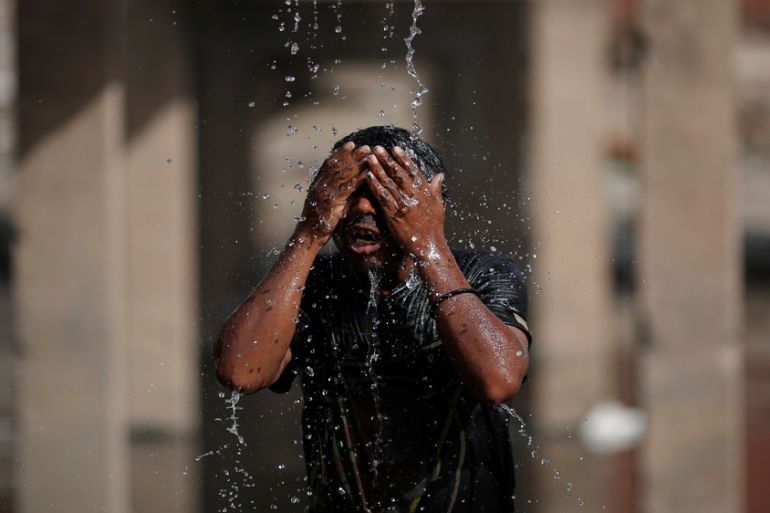India’s rising temperatures already deadly, study shows
Heat-related mortality may increase as 25 percent of country’s total population lacks access to electricity.

India is now two and a half times more likely to experience a deadly heat wave than a half century ago, and all it took was an increase in the average temperature of just 0.5C, a study shows.
The average temperatures in India rose by more than 0.5C between 1960 and 2009, the probability of India experiencing a massive heat-related mortality event – defined by more than 100 deaths – shot up by 146 percent, a study published in the journal Science Advances reveals.
Keep reading
list of 4 itemsChina evacuates over 100,000 as heavy rain continues to lash south
Asia bears biggest climate-change brunt amid extreme weather: WMO
Photos: Highest-level rainstorm warning issued in south China’s Guangdong
“There has been an increase in heat waves from 2013-2016 and a decrease in cold waves.
This is because of the increase in global temperature. 2016 has been the warmest year in India when hundreds of people died due to the heat wave,” DS Pai who is a climate scientist with India meteorological department, told Al Jazeera.
“The present year temperatures are also above the normal but we expect that it won’t be as warm as 2016. But the increase in temperature is going to impact the air and water quality.”
READ MORE: France and India pledge to combat climate change
Last year in May, India recorded a record 52.4C in the western city of Jaisalmer.
Ministry of Earth Sciences (MoES) in India shows that at least 4620 people have died in last four years due to the heatwave. In Andhra Pradesh and Telangana alone, 4,246 people died due to the heatwave.
The findings are sobering considering that the world is on track for far more warming.
For the last two weeks much of Asia has been gripped by a heat wave, with a record high of 53.5C set in the southwest Pakistani city of Turbat on May 28 – the world’s hottest-ever temperature recorded for the month of May.
Temperatures in the Indian capital of New Delhi have soared beyond 44C.
![Temperatures in New Delhi have soared beyond 44C already this year [Cathal McNaughton/Reuters]](/wp-content/uploads/2017/06/43652ad0ab8c4b1682c09e5110edbeeb_18.jpeg)
India is already struggling with the rising pollution as about 1.1 million people to die prematurely each year in India due to the rapidly worsening air pollution which is now surpassing China‘s as the deadliest in the world.
The number of premature deaths in China caused by dangerous air particles, known as PM2.5, has stabilised globally in recent years but has risen sharply in India, according to the report, by the Health Effects Institute, a Boston research institute focused on the health impacts of air pollution, and the Institute of Health Metrics and Evaluation, a population health research center in Seattle.
India has registered an alarming increase of nearly 50 percent in premature deaths from particulate matter between 1990 and 2015, the report says.
|
|
With these changes in the environment even if countries are able to meet the Paris Agreement goals in curbing climate-warming carbon emissions that would still only limit the global temperature rise to an estimated 2C.
“It’s getting hotter, and of course more heat waves are going to kill more people,” said climatologist Omid Mazdiyasni of the University of California, Irvine, who led an international team of scientists in analyzing a half century of data from the Indian Meteorological Department on temperature, heat waves and heat-related mortality.
“We knew there was going to be an impact, but we didn’t expect it to be this big.”
The study also found that the number of heat wave days increased by 25 percent across most of India.
Areas in the south and west experienced 50 percent more heatwave events, or periods of extreme heat lasting more than three or four days, in 1985-2009 compared with the previous 25-year period.
“The general public may think that a 1 or 2 degree temperature rise is not that significant, but our results show that even small changes can result in more heat waves and more death,” said Amir Agha Kouchak, another climatologist at UC Irvine and a co-author of the report.
Scientists have warned for years that climate change will make heat waves more intense, more frequent and longer lasting.
“It stands to reason there would be more dire health impacts with more severe heat waves, and this paper provides a key quantification of those impacts for one region of the world,” said climate scientist Gerald Meehl of the National Center for Atmospheric Research in Boulder, Colorado, who was not involved in the study.
The same methodology can be applied in any region to get a sense of how vulnerable a country or population might be, the authors said.
READ MORE:Heatwaves hit much of Asia earlier than expected
For the India’s fast-rising population and low income levels among the poor, the scientists have found an even stronger correlation between heat waves and deaths among those who are poor.
The vast majority of India’s 1.25 billion people are poor and have few options as temperatures hit sweltering levels, drying forests and riverbeds and wiping out farm animals.
They are unlikely to have air conditioners – up to 25 percent still have no access to electricity.
Most in India rely on agriculture for their livelihoods, and climate change is likely to hurt their crops.
Many who work as farmers or in construction will have to shorten their work days by two-three hours within four decades, simply because it will be too hot outdoors, according to a report last year by the UN Environment Program.
Most Indian cities and states are not prepared to handle more heat, even if they understand the devastation it can wreak.